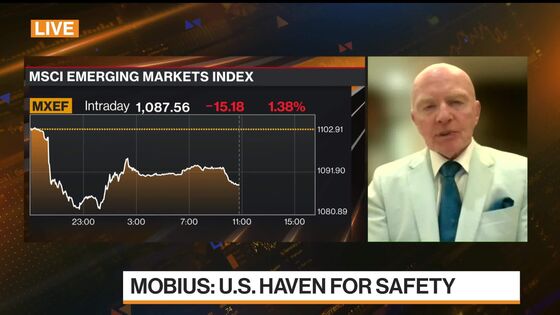Stock Market Bottom Slipping Away After 13 Years of Dip-Buying
Whether bulls will be rewarded for their courage this time is the most urgent question in markets.
(Bloomberg) -- Thirteen years since stocks hit their financial-crisis bottom, and two years out from the Covid capitulation, equity bulls are again hoping March will be the month when a spiraling market finds its floor.
Their faith is being severely tested.
Pockets of resilience were on display in the past five days, though stocks skidded further amid surging inflation and war in Europe. The S&P 500’s biggest one-day tumble since 2020 was followed closely by its biggest rally, and every session except Monday’s featured at least one notable bounce.
So it was this week, and so it has been since March 2009, when the dip-buying ethic was born as the Federal Reserve flooded the financial system with money to end the financial crisis. Whether bulls will be rewarded for their courage this time, when no such aid is likely, is the most urgent question in markets.

“After a long period of no volatility, we’ve got so much volatility,” Sarah Hunt, portfolio manager for Alpine Woods Capital Investors, said in an interview on Bloomberg TV. “It’s a very different environment than we’ve been in for the last several years.”
The week started with a brutal downdraft before a 2.6% bounce Wednesday -- 13 years to the day the market bottomed after the financial crisis. That didn’t hold up into the end of the week, as stocks slid another 1.7% to end the five days lower by nearly 3%.
But the two-week slump since the war started hasn’t deterred retail investors from trying to time the end of the market’s drop. In the week up to March 9, Investors poured $8.8 billion into U.S.-focused equity funds, the most in a month, EPFR Global data compiled by Bank of America Corp. show. Retail investors purchased a net $1.7 billion of stocks in the week ended Thursday, extending a two-month spree that according to JPMorgan Chase & Co. was the largest at this point in at least five years.

Strategists and money managers have been scouring for signals to determine whether that retail optimism will be rewarded -- as it has been time and again in the post-crisis era, with anyone who came close in March of 2020 potentially doubling their money in 16 months.
One lens considers the history of past corrections. According to Leuthold Group, anyone who has bought the S&P 500 on the day it reached a 10% decline since 1960 would have been sitting on profits 81% of the time a year later. The average gain of 12% compares with an average return of 9% in all periods.
As tempting as that outcome is, an investor had to be prepared for a lot of short-term stress getting there, with losses frequently reaching the double digits. To avoid the worst days, Doug Ramsey, Leuthold’s chief investment officer, found that it’s better to buy the dip 25 days after the market’s initial entry into a correction. Doing that would only incur a maximum decline of 3.6% during the first month.

Another parameter to consider is the unemployment rate, a factor that informs the stage of an economic cycle. Ramsey found that dip-buying is safer in the early or middle part of an economic expansion than during a maturing stage -- such as now. Bargain hunting at times when the jobless rate was above 5% produced a 12-month return of 16%, versus 6% when the unemployment rate was lower.
“Analysts who entered the business in 2009 or later haven’t experienced anything other than big wins from buying the dips,” he said.
Keith Lerner, co-chief investment officer and chief market strategist at Truist Advisory Services, is combing the options market clues for whether those bets will pay off. He’s watching for a spike in the put-to-call ratio, which would signify demand for downside insurance. He’s also eyeing sentiment surveys, which tend to give contrarian signals. He wants to see “extreme buying pressure, a buying thrust,” meaning an up-day with huge volumes.
“You really want to see buyers coming in with force. That, with strong breadth readings, often marks a low,” he said by phone.
Shifting investor attitudes are also of interest to iCapital’s Anastasia Amoroso, though she is particularly focused on a “capitulation” in sentiment and how that may be reflected in positioning. She notes that while hedge fund net leverage is down from record levels in 2021, it has not reached the lows of 2020, also adding that dip-buying and overall fund flows into global equities have been resilient to start the year.
“History tells us that the more capitulation we see in these measures, the greater the potential for market upside in the following months,” Amoroso said in a note dated March 9. “Given the fast pace of developments and continued reduction in hedge fund positions this week, we will monitor these positioning measures closely.”
Still, caution abounds despite the tools strategists have at their disposal, especially for those who remember too well the challenges of calling for a bottom in times of historic financial stress.
Take Max Gokhman, chief investment officer for AlphaTrAI, for instance. Back in March 2020, he was optimistic about the fiscal stimulus measures that were being put forward. The 2008 crash, on the other hand, had many more variables at play, clouding the outlook, and the current period feels more akin to that. Consumer sentiment has soured, there’s a wage problem even with a tight labor market and the yield curve could invert soon, he said.
“I’ve had people reach out to me about, is this the bottom and are we actually now in a position to buy the dip?” he said by phone. “To me, it doesn’t seem like this is the time to buy the dip just yet. I do think there will be that point this year, but I don’t think we’re there yet.”
©2022 Bloomberg L.P.